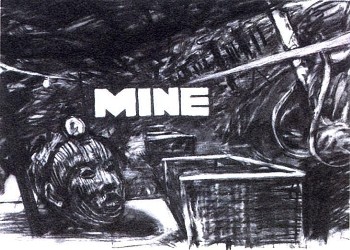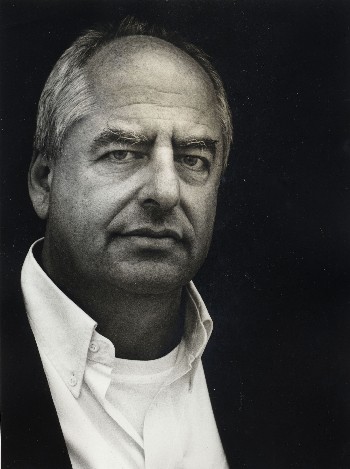Fuse Feature: Vertical and Contingent — A Dispatch from William Kentridge’s Norton Lectures
The decisions William Kentridge makes in his minute to-ings and fro-ings are akin to the decisions a poet makes as she works her measure over and over again.
Information Regarding William Kentridge’s Charles Eliot Norton Lectures. The lectures are held in Sanders Theatre in Memorial Hall at Harvard University, Cambridge, MA. Tickets are required and are available beginning at noon on the day of each lecture at the Harvard Box Office in the Holyoke Center or by phone (service charge applies to phone orders) and starting at 2 p.m. at Sanders Theatre. Limit two tickets per person. See end of this dispatch for a list of the remaining lectures.
Here is the dispatch from Drawing Lesson One.
Here is the dispatch from Drawing Lesson Two.
Drawing Lesson Three, “Vertical Thinking: A Johannesburg Biography”
Introduced by Benjamin Buchloh. April 3.
By Daniel Bosch.
In his short animated film, Mine (1991), William Kentridge has depicted a South African minerals magnate at repose—someone has made his bed, and now he lies in it. As in a dream, the bed morphs and the static magnate’s lap is transformed into a desktop, upon which a French press coffeemaker appears. When the heavy-handed CEO depresses the coffeemaker’s plunger, he unwittingly initiates a journey to the center of the earth: the plunger drills a deep shaft into the mine of the title, into the vast, shadowed realm that underlies our doing, our thinking, our aspiring. Each stratum passed by the plunger is crowded with artifacts natural and unnatural, bodies and things once covered, now discovered—for the moment, for Kentridge proceeds by incremental mark-making and dutiful erasure. As it metaphorizes artifacts as ore to be collected and refined, Mine asks, “How shall we explore and exploit history?” Kentridge’s answer is that we must depict it so we can see it, but then we must immediately alter it.
In Vertical Thinking: A Johannesburg Auto-biography, the third of the Norton Lectures given by Kentridge, Mine is not only the place where a resource (a consequence of natural history having taken its course) is exploited by commerce (a conditioned response to social conditions), but first-person possessive pronoun. Yes, Kentridge’s short film tells us about the Universe, about Earth, about Africa, about South Africa, about the Transvaal, and about Johannesburg, but as we draw closer to ground zero, to Kentridge’s grade school and to the eight- or nine-year-old Kentridge in a particular desk in that school, we reach the pinch of the funnel, a person-point of resistance named “William,” for whom the images that make up the film are “mine.”
It exerts a lot of pressure, such a vertical consciousness, the idea that ultimately the Universe rides atop your own personal barometric column. Such pressure might be measured in units called “atmospheres.” Or it might be figured by masses that crush dark carbon into translucent diamonds. Or its effects over time might be expressed more compactly by a singularity, an extraordinary cataclysm, such as the impact, two billion years ago, of a tremendous meteor just 100 kilometers from what is now Johannesburg, which was in part responsible for the disposition of minerals in the area and thus, eventually, for the gold rush that led to the founding of Johannesburg in 1886. (The Vredefort impact site is today a UNESCO World Heritage site.) It might be said, using a pop psychological shorthand, that only a child who is conscious of his place in such a vertical column could have produced Kentridge’s art—that the incidents and accidents on the surface of the earth could not provide a sufficient account.
Kentridge acknowledged such vertical pressure in his suggestion that in certain acts of creation one might, over time, construct a vertical counter-funnel, an ever-widening, inverted tree of family that would ramify in the metaphorical soil below one’s feet. (Here the equivocation of artistic creativity with procreation is mine, not Kentridge’s.) Cosmological is above and genealogical below: Kentridge’s consciousness of how he has been fixed in place is matched by a consciousness of how his descendants might disperse his genotype, diluted by half again and again, at each generative nexus. Above him, an infinitely expanding reference point, born in the big bang and withdrawing at the speed of light; below him, a pyramid that takes literal generations to build and that grows, oddly enough, from its base down, while at every level it maintains vestiges of the artist at its apex. If it is an arrogance to see one’s self at the crux of such an hourglass, the vision isn’t entirely self-aggrandizing: each of us who has offspring might eventually be seen to reside at the top of a pyramid written in Gs and As and Ts and Cs and made light by the empty spaces in its helices. And it might be said—to our shame as well as to our glorification—that in each piece of work one leaves behind, one leaves at least a trace of one’s self.
Needless to say, in neither of Kentridge’s vertical funnels is there room for necessity: he could have been born in Pretoria or Peoria. His as-yet unborn granddaughter may become President of South Africa, head of Apple Computers, or a poet who writes dispatches for an online arts journal. Kentridge acknowledged such contingency again and again, most poignantly when he proposed that the artist-making-the-image and the artist-looking-at-the-image ought to be joined in a trinity with the artist-who-drinks-tea-but-who-for-some-utterly-contingent-reason-feels-compelled-to-bring-a-French-press-coffeemaker-into-the-studio—the one who prompted the artist-making-the-image to discover that a boor might bore as deeply as Kentridge wills him to. Kentridge’s autobiography is just as contingent: “What if I had been slightly better at making art in the manner of Jules Olitski?” Kentridge mused. “What if I had been only slightly less bad a student in acting school?” The success of the artist-who-makes-images, it seems, is predicated upon his failures.
William Kentridge – MINE (1991) from glasscapsule on Vimeo.
For Kentridge the film-maker, the limits of contingency are framed by tiny acts of making. The frame is as narrowly-defined as the short, cyclical trip he makes from the paper to which he presses his charcoal and eraser to the camera a few feet away and back to the paper again. The frame’s audible form is the sound of a smudge or two followed by the clack of shoes on cement flooring followed by clicks of the shutter; a coda of clacks sounds his return to mark-making. In this narrow compass, under an infinite immensity and above a gradual diminishment of self, Kentridge walks back and forth, solving no big problem at once, making works that address world-historical issues a thumb-rub at a time.
If this were a different venue, I’d digress here into a discussion of how Kentridge’s artistic confinement, his practice of walking back and forth between the camera that preserves and the image that is always just about to be once again in-progress repeats the fundamental motion of agriculture. At the point where the first large scale cultures became viable, humans plowed, sowed, weeded, and reaped, and as we did, we passed over the same terrain, and the horizontality of our passage induced a vertical imagination that found its expression in lines of verse, the root of which means “to turn” as one turns a plow. The decisions Kentridge makes in his minute to-ings and fro-ings are akin to the decisions a poet makes as she works her measure over and over again.
Late in Vertical Thinking, Kentridge turned his hourglass on its side, as one might do when one wishes to stop the marking of time’s passage. With his funnels horizontally rather than vertically-oriented, he imagined their point of contact not as a person but as the pin-hole aperture of a camera. On the diurnal, outside of the box, the Universe pelts the hole with a constant stream of photons. (Here we are outside Plato’s cave, in the blinding glare of reality, thank you very much, Enlightenment rationality.) Inside the camera (as in the cinema, as inside Plato’s cave), a funnel of light is projected from the pinhole toward a wall where the images it bears appear and our subjectivity is our only tool.
Shall we trust what we see on that wall? A contingent answer might be expected next Tuesday, when Kentridge presents, Practical Epistemology: Life in the Studio.
Drawing Lesson Four, “Practical Epistemology: Life in the Studio”
Introduced by Maria Gough. April 10, 4 p.m.
Drawing Lesson Five, “In Praise of Mistranslation”
Introduced by Glenn Lowry. April 16, 4 p.m.
This is the only lecture not on a Tuesday
Drawing Lesson Six, “Anti-Entropy”
Introduced by Peter Galison. April 24, 4 p.m.
Kentridge’s Norton Lectures will not be followed by Q & A. Instead, a separate opportunity to converse with Kentridge has been scheduled for Monday, April 23rd at 4 p.m. This extra session is to be held in Emerson Hall 105.
The Charles Eliot Norton Professorship in Poetry was endowed in 1925 by C. C. Stillman (Harvard 1898). Incumbents are in residence through their tenure in the Chair and deliver at least six lectures. The term “poetry” is interpreted in the broadest sense, to include all poetic expression in language, music, or fine arts.
Previous holders of the Norton Chair include Gilbert Murray (1926–27), T. S. Eliot (1932–33), Igor Stravinsky (1939–1940), Charles Eames ((1970–1971), Leonard Bernstein (1972–1973), Frank Stella (1982–84), John Cage (1988–89), Nadine Gordimer (1994–1995), and Orhan Pamuk (2009–2010).


